How Sales Proposal Software Improves Speed, Consistency, and Wins
Article written by
Kate Williams

INSIDE THE ARTICLE
SHARE THIS ARTICLE
Summary
Manual proposals are slow, inconsistent, and error-prone. Sales proposal software changes the game—turning hours of formatting into minutes of strategic selling. It ensures professional design, real-time collaboration, CRM integration, and insights into buyer engagement. The result? Faster proposals, higher close rates, and happier reps. If you’re still using Word, you’re already behind.
How many times have you wondered, 'I wish there was a genie who created proposals in seconds for me'? While you might be stuck manually managing, creating, and tracking down each proposal, most of your competitors have already won that deal. That's the power of having speed and consistency as your superpower. In this blog, let us dig deeper into what you might already be aware of about proposal creation; if not, this is your chance to give a new perspective to your sales proposal job.
Why Traditional Proposal Creation Is Killing Your Deals
Most sales teams groan the moment a prospect says, “Can you send us a proposal?” Instead of excitement, it sets off a chain reaction of delays.
Here’s how it usually goes:
- Sales pulls up the last “similar” deck, swapping out client names and hoping they don’t miss one.
- Marketing jumps in to check branding and polish messaging, but they’re juggling campaigns.
- Legal combs through contract clauses, flagging outdated terms.
- Finance gets pulled in last minute to verify pricing.
- Meanwhile, the buyer is waiting… and waiting.
By the time your proposal finally lands, the momentum has shifted. Buyers who were eager after the demo are now distracted—or worse, they’ve already engaged with a faster competitor.
What This Really Means for Your Pipeline?
Check this out:
Lost momentum = lost deals
Timing is everything in sales. According to InsideSales research, 50% of buyers choose the vendor that responds first. If it takes your team a week to send a proposal, you’ve already ceded ground. In fact, B2B buyers now expect real-time or next-day turnaround on critical sales materials. Every extra day signals disorganization—and buyers associate slowness with risk.
Inconsistencies erode trust
When each rep builds proposals their own way, you end up with conflicting information. One prospect sees last quarter’s pricing, another sees an old compliance clause, and branding looks different from one file to the next. Buyers notice. In fact, Gartner research shows 61% of B2B buyers cite inconsistent information as a major reason for not trusting vendors. If your proposal looks sloppy or mismatched, prospects start to wonder, “Will working with them be just as messy?”
Sales reps spend less time selling
Proposals are supposed to move deals forward, but the manual process does the opposite. Studies show 57% of sales professionals spend 40+ hours per week on proposals—basically a second full-time job. That’s time not spent prospecting, building relationships, or closing business. Every hour lost to formatting documents or chasing internal approvals is an hour you’re not selling.
Traditional processes don’t scale
The patchwork approach (Word docs, email threads, PDFs) might have worked when deals were slower and simpler. But in today’s environment—where buying cycles are compressed, stakeholders multiply, and personalization is expected—it falls apart. A Salesforce survey found 65% of buyers expect tailored, personalized interactions at every stage. Traditional processes simply can’t keep up with that demand at scale.
Instead of accelerating deals, traditional proposal creation drains time, introduces errors, and kills momentum. What should be your strongest sales asset too often becomes your weakest link. In a high-velocity sales environment, the slow, manual approach isn’t just inefficient—it’s a competitive disadvantage.
4 Major Challenges in Traditional Proposal Creation
Why do manual proposals so often fail to deliver? On the surface, it looks like just “extra admin,” but the problems run deeper. When you zoom in, four big challenges stand out—each of them capable of slowing deals, eroding trust, and frustrating both sellers and buyers.
1. Lack of Structure and Clarity
Manual proposals are usually stitched together from past decks, Word documents, and email notes. The end result often reads like a patchwork quilt—repetitive sections, disorganized flow, and no clear storyline. From the buyer’s side, this is exhausting. They have to sift through jargon-heavy slides and disconnected paragraphs just to understand your value proposition. And in enterprise sales, where decision-makers often skim rather than read, a poorly structured proposal almost guarantees your key points will get lost.
2. Generic Content
Copy-paste is the silent killer of proposals. In an attempt to save time, reps often reuse old templates with minimal editing. While it feels efficient, buyers see right through it. Every prospect has unique needs, challenges, and goals. When they read a proposal filled with boilerplate text and vague promises, it doesn’t feel tailored—it feels dismissive. Instead of engaging, they disengage.
3. Manual Inefficiency
Ask any sales rep what slows them down, and proposals will be near the top of the list. Why? Because the manual process is riddled with inefficiencies:
- Digging through shared drives for the latest case study.
- Emailing marketing for an updated slide design.
- Waiting on legal for the right compliance clause.
- Formatting, reformatting, and chasing approvals across departments.
Each step adds hours of unnecessary work and introduces more opportunities for mistakes. A misplaced decimal in pricing, an outdated product feature, or a missing signature block can derail the entire deal.
4. No Visibility Post-Send
Perhaps the most frustrating challenge: once you hit “send” on that PDF, you’re flying blind. You don’t know if the buyer opened it, shared it internally, or abandoned it after the first page. This lack of visibility makes follow-up a guessing game. Do you call the next day? Wait a week? Push harder, or stay patient? Without engagement data, even the most experienced sellers are forced to rely on gut instinct.
And here’s the kicker: buyers expect smarter, more proactive engagement. If your competitor is using modern proposal software with real-time tracking (open rates, time spent per section, comments), they can follow up with precision while you’re still guessing.
The Cumulative Effect
Put all four challenges together, and the impact is clear:
- Proposals lack clarity → buyers get confused.
- Content feels generic → buyers disengage.
- Processes waste time → reps sell less.
- Visibility is nonexistent → follow-ups miss the mark.
Instead of being a growth engine, proposals become a drain on time, energy, and credibility. In today’s high-velocity sales environment, those are losses no team can afford.
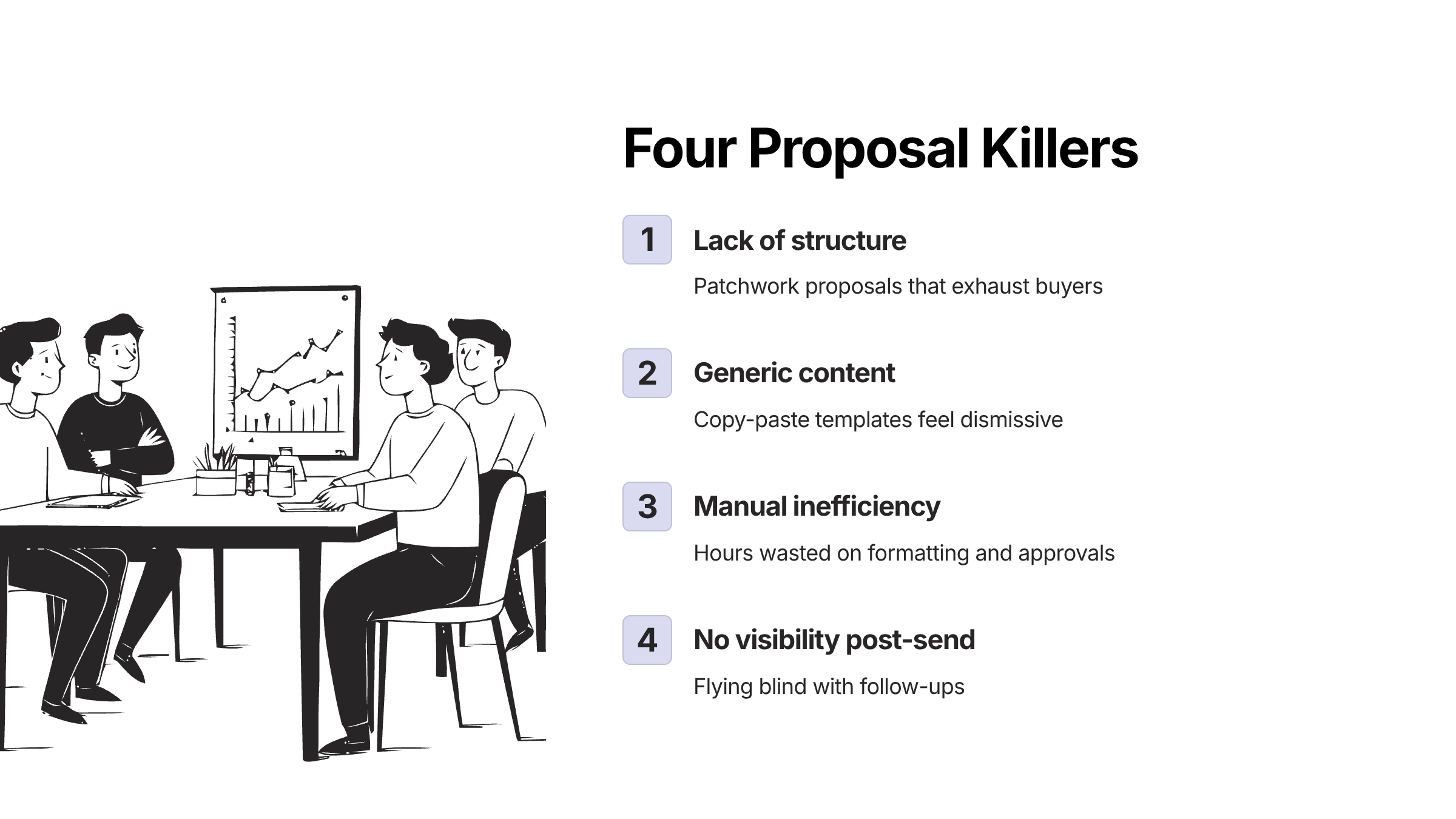
The Modern Switch to Sales Proposal Software
When manual processes pull the teams down, modern proposal platforms transform proposals from static documents into intelligent, collaborative, and trackable sales assets. Let’s break down each capability in detail:
1. Quick Creation via Branded Templates
Proposals are no longer created from scratch. Sales teams start with pre-approved, branded templates that lock in logos, fonts, tone, and visual design.
- Marketing ensures every proposal reflects the company’s brand identity.
- Sales reps simply fill in client-specific details instead of reinventing the wheel.
- Content libraries provide instant access to approved case studies, product descriptions, and legal language
Impact: A process that once took hours now takes minutes.
2. Real-Time Collaboration Across Teams
In traditional workflows, proposals bounce between sales, legal, and marketing in endless email chains. Modern platforms eliminate this by enabling simultaneous collaboration:
- Sales adds pricing and customer context.
- Legal reviews clauses in real time.
- Marketing polishes visuals and messaging.
No more v12_final_FINAL.docx headaches. Version control is automatic, so everyone works on the latest file.
Impact: Cross-functional teams move from sequential bottlenecks to parallel workflows, cutting delays by days.
3. Automated Approvals and E-Signatures
Internal approvals and buyer signatures are notorious deal-slowers. Proposal software automates this step:
- Internal routing: Approvals are triggered automatically and sent to the right managers.
- E-signature integration: Buyers can sign directly within the proposal—no printing, scanning, or mailing required.
- Follow-ups: Automated reminders nudge stakeholders who haven’t signed.
Impact: Deals that used to take weeks of back-and-forth now close in hours.
4. Analytics and Buyer Engagement Tracking
This is where modern software gives sales teams a superpower. Instead of sending a PDF into a black hole, reps get real-time engagement insights:
- Who opened the proposal (and when).
- Which sections they spent the most time on.
- Whether the document was forwarded internally.
- Drop-off points where buyer interest waned.
Impact: Reps know when to follow up and what to address.
5. CRM and Tech Stack Integrations
Proposal software integrates seamlessly with CRMs like Salesforce, HubSpot, or Microsoft Dynamics.
- Auto-population: Client details, product info, and pricing are pulled directly from the CRM.
- Sync back: Updates to the proposal (like discounts or custom terms) sync back to the CRM automatically.
- Wider ecosystem: Many platforms also integrate with CPQ systems, contract management tools, or payment platforms.
Impact: No double data entry. Sales pipelines stay accurate, finance stays aligned, and teams save hours in administrative work.
6. Personalization at Scale
Buyers expect proposals to feel tailored to them—not copy-paste templates. Proposal platforms deliver personalization without extra effort:
- Pulls data from the CRM to customize names, industries, and pain points.
- Inserts relevant case studies and testimonials by industry or region.
- Adapts pricing and product bundles to client needs.
Impact: Every buyer receives a proposal that feels handcrafted—even when it was generated in minutes.
7. Compliance and Risk Reduction
In regulated industries, a single outdated compliance clause can disqualify a proposal. Proposal software mitigates that risk:
- Pre-approved legal language is stored in the content library.
- Role-based permissions prevent reps from editing sensitive terms.
- Audit trails log every change for compliance reporting.
Impact: Enterprises reduce compliance errors, avoid costly penalties, and maintain credibility with regulators and clients alike.
8. Faster Deal Cycles
Every day a proposal sits unsigned is a day buyers reconsider. Proposal software accelerates the cycle with:
- Instant delivery post-demo.
- Integrated e-signatures.
- Automated follow-ups and reminders.
- Mobile-optimized designs so buyers can review and sign anywhere.
Impact: Companies using proposal automation often report 20–30% shorter sales cycles, with some cutting turnaround times by more than half.
9. Improved Buyer Experience
Proposals aren’t just internal efficiency tools—they’re client-facing assets. Buyers judge your professionalism by how polished and interactive your proposals feel.
Modern platforms enable:
- Interactive pricing tables that let buyers explore options.
- Embedded videos or demos to explain complex solutions
- Mobile-responsive designs for seamless review on any device.
- Commenting features for real-time collaboration with buyers.
Impact: Instead of a static PDF, buyers receive a digital experience that feels consultative and modern—giving your team an edge over competitors stuck with clunky documents.
The Combined Result
When you put these capabilities together, the transformation is clear:
- Proposals go out faster.
- Messaging stays consistent.
- Buyer engagement is visible and trackable.
- Deals close sooner and more often.
Proposals stop being bottlenecks and become strategic growth accelerators.
The Different Types (And Which One’s Right for You)
Just as no two businesses sell in exactly the same way, no single proposal tool fits every sales motion. Some teams need speed and simplicity. Others need enterprise-grade compliance and scalability. The key is matching the tool to your deal size, sales cycle, and industry requirements.
Let’s break down the main categories:
1. Client Management Tools
Best for: Small businesses, freelancers, and agencies that want all-in-one platforms.
These tools combine proposals, contracts, invoicing, and project management in one place. Instead of juggling multiple apps, small businesses can handle the entire client lifecycle under a single roof.
- Strengths: Simplicity, affordability, and “do-everything” appeal.
- Limitations: Not as customizable or powerful for complex sales cycles.
Examples: HoneyBook, Bonsai.
If you’re a small business owner who values ease over complexity, this is your lane.
2. Sales Enablement Platforms
Best for: Mid-market teams focused on marketing-sales alignment and content distribution.
Sales enablement platforms provide centralized access to sales collateral (case studies, decks, and one-pagers) and streamline the way reps build proposals. They bridge the gap between marketing and sales by ensuring reps always have on-brand, approved assets at their fingertips.
- Strengths: Consistency in messaging, faster access to content, better buyer engagement tracking.
- Limitations: Not designed for heavy RFP workflows or complex pricing.
Examples: SparrowGenie, Dock, Highspot.
Choose this if your challenge is reps going off-brand or wasting time hunting down the right slide or case study.
3. Response Management & RFP Platforms
Best for: Enterprises managing complex, high-volume RFPs, RFIs, or RFQs.
RFP software is built for heavy lifting—handling hundreds of questions, pulling responses from a centralized knowledge base, and managing cross-functional collaboration at scale. These platforms are compliance-heavy and often include features like audit trails, permissions, and integrations with procurement portals.
- Strengths: Handles scale, ensures compliance, increases win rates on high-stakes RFPs.
- Limitations: More expensive and complex to implement. Overkill for SMBs.
Examples: RFPIO, Responsive, Loopio.
If your team spends more time responding to RFPs than building proactive proposals, you need this category.
4. CPQ (Configure, Price, Quote) Systems
Best for: Industries with complex pricing models, product bundles, or variable configurations (e.g., SaaS, telecom, manufacturing).
CPQ software ensures pricing accuracy by pulling directly from product catalogs, applying rules, and generating dynamic quotes. It often integrates deeply with CRM and ERP systems.
- Strengths: Eliminates pricing errors, speeds up complex quotes, and improves deal margins.
- Limitations: Setup can be technical, and ROI is best for teams with large deal sizes and complex pricing needs.
Examples: DealHub, PandaDoc, Salesforce CPQ.
If your reps waste time checking with finance on pricing or risk sending out inaccurate quotes, CPQ is your answer.
5. Template-Based Proposal Generators
Best for: SMBs and lean sales teams that prioritize speed and repeatability.
These tools offer ready-to-use templates where reps can quickly plug in client details and send polished proposals. They often include light analytics, basic e-signature integration, and mobile responsiveness.
- Strengths: Affordable, fast to adopt, and perfect for teams that send many short-cycle proposals.
- Limitations: Less depth for compliance-heavy industries or large-scale RFPs.
Examples: Proposify, GetAccept, Qwilr.
If you send lots of proposals that follow a similar format, this category gives you the biggest lift for the lowest effort.
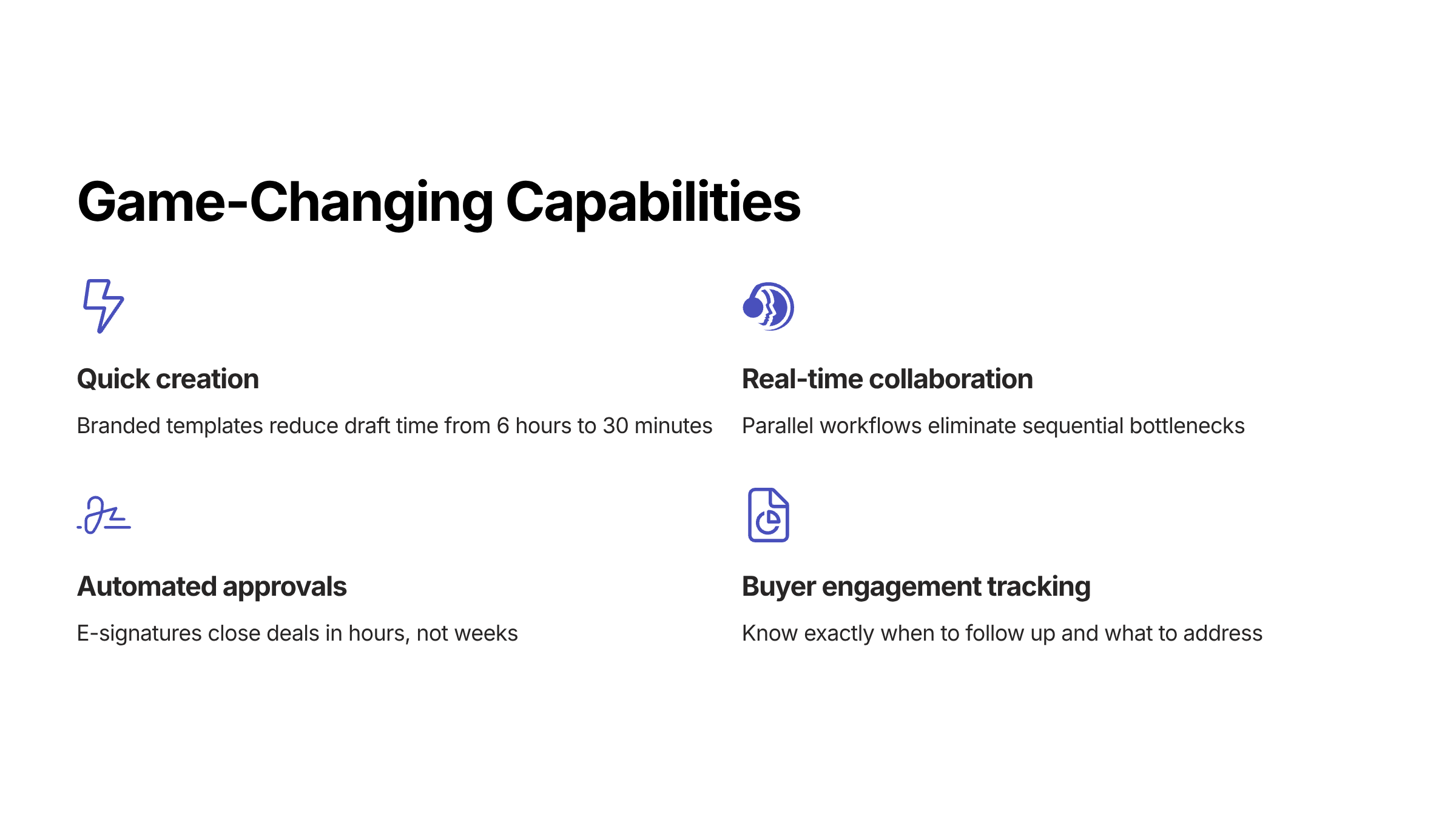
Sales Proposal Transformation with AI
AI has taken proposal software from helpful to transformative. Here’s what’s possible today:
- Instant drafts: Tools can auto-generate proposals straight after a discovery call by pulling insights from call transcripts and CRM records
- Personalized at scale: AI adapts content to each buyer’s industry, pain points, and role in seconds
- Predictive nudges: Some platforms analyze engagement patterns and suggest the best time for reps to follow up.
- Embedded storytelling: Interactive elements (like videos or ROI calculators) make proposals more engaging
AI makes proposals feel like they were hand-crafted—without eating up hours of rep time.
Benefits of AI-powered Proposal Software
The shift to AI in proposal management isn’t just about making things faster—it’s about making proposals smarter, more personalized, and more scalable. From personalization at scale to compliance guardrails, the benefits ripple across sales, legal, marketing, and leadership. Here’s how AI transforms the proposal game:
Personalization at Scale
AI pulls insights from CRM records, call transcripts, and content libraries to tailor every proposal to the buyer’s industry, role, and pain points. What once took hours of manual editing is now automated in minutes, ensuring every client feels seen. Personalized proposals resonate more deeply with buyers, keeping them engaged longer. This kind of relevance is what turns proposals from generic documents into decision-making tools.
Compliance and Risk Reduction
Proposal errors aren’t just embarrassing—they can cost deals or even lead to legal exposure. AI ensures only pre-approved legal and compliance language is used, reducing errors and protecting your brand. Role-based permissions prevent unauthorized edits, and audit trails track every change. The result: proposals that meet enterprise-grade compliance without slowing down the sales cycle.
Content Reuse and Knowledge Management
Instead of digging through old decks or Slack threads, reps pull from a centralized, AI-powered content library. Frequently used assets—like case studies, technical specs, or compliance answers—are instantly available. AI even suggests the best-fit content for a given deal, based on past wins and buyer profile. This ensures consistency while freeing reps from repetitive searching and copy-pasting.
Forecasting and Deal Intelligence
AI doesn’t just generate proposals—it helps predict deal outcomes. Engagement analytics reveal who opened the proposal, where they lingered, and what they ignored. This data gives sales leaders visibility into which deals are heating up and which need attention. The result is more accurate forecasting and smarter resource allocation.
Dramatic Time Savings
AI automates repetitive tasks like data entry, formatting, and asset gathering. Ticomix reported cutting proposal writing time by 80% after adopting AI-driven automation. Reps win back hours that can be reinvested in discovery calls, prospecting, and closing. Time stops being wasted on admin and starts fueling revenue growth.
Error Reduction
Manual proposals are rife with risks—wrong numbers, outdated language, missing details. AI eliminates these by pulling directly from source-of-truth systems like CRM and CPQ. Automated validation checks catch mistakes before they reach the client. Companies have reported up to 95% fewer proposal errors with AI-powered workflows.
Improved Win Rates
Speed, accuracy, and personalization all compound into higher win rates. Buyers trust consistent, error-free proposals that arrive while interest is high. Companies report 40–53% higher close rates with proposal automation in place. In competitive deals, the vendor with the faster, sharper proposal often wins.
Buyer-First Experience
AI-powered proposals aren’t static PDFs—they’re interactive sales experiences. Buyers explore pricing tables, watch embedded videos, and comment directly in the proposal. Mobile-responsive designs ensure executives can review and sign anywhere. The smoother the experience, the easier it is for buyers to say yes.
Scalability Without Headcount
As proposal volume grows, traditional teams burn out or require more hires. AI enables teams to handle more proposals with the same headcount by automating the heavy lifting. Content reuse, workflow automation, and e-signatures keep throughput high. For RFP-heavy industries, scalability is the difference between stagnation and growth.
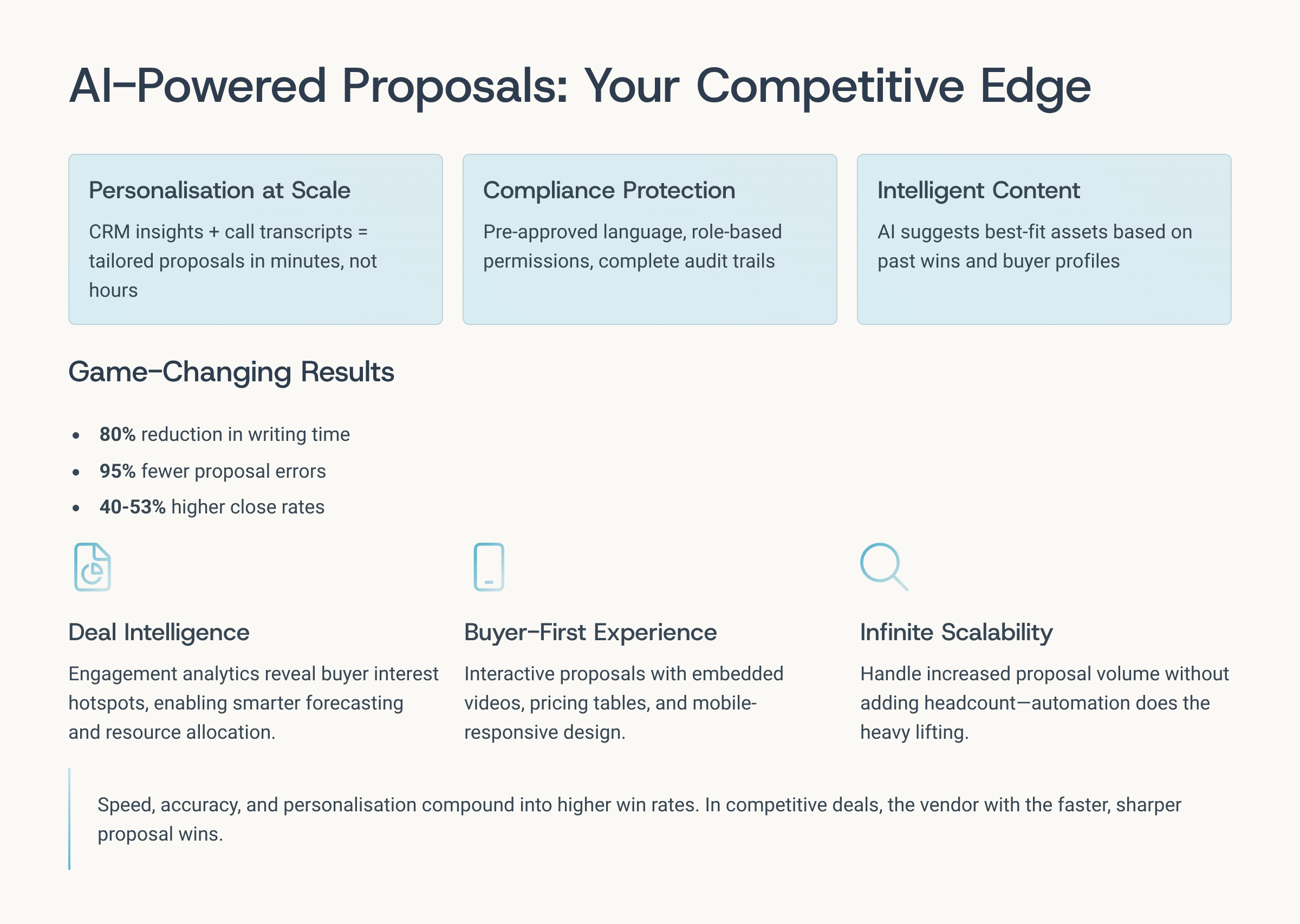
10 Features of Proposal Software
Modern proposal software isn’t just a document builder. It’s a full-fledged sales acceleration engine designed to streamline creation, maintain consistency, ensure compliance, and give sales teams visibility into buyer behavior. From your research files, here are the features that matter most—and why they matter.
1. Customizable, Brand-Locked Templates
Proposals start with pre-approved, design-consistent templates that lock in logos, fonts, colors, and voice.
- Sales teams don’t waste time formatting slides or documents.
- Marketing ensures every outgoing proposal reflects the brand.
- Consistency across proposals builds buyer trust and credibility
2. Centralized Content Libraries
A searchable, AI-powered library houses the latest case studies, product specs, and compliance language.
- Reps no longer dig through drives or emails to find the “right” content.
- Legal and marketing teams maintain a single source of truth.
- Ensures every proposal contains accurate, up-to-date, and compliant information
3. Real-Time Collaboration and Version Control
Proposal software enables multi-user editing with automatic version control.
- Sales, marketing, and legal can contribute simultaneously.
- No more juggling v12_FINAL.docx files.
- Parallel workflows replace sequential bottlenecks, cutting days from the cycle
4. Workflow Automation and Approvals
Automated workflows handle internal reviews and client approvals.
- Proposals auto-route to the right managers for sign-off.
- Approval delays shrink as reminders are sent automatically.
- Bottlenecks disappear, helping proposals move forward faster
5. E-Signature Integration
Built-in e-signatures turn proposals into end-to-end sales closers.
- Clients sign directly inside the proposal, on any device.
- No need for printing, scanning, or third-party signature tools.
- Reduces turnaround times from weeks to hours
6. CRM and CPQ Integrations
Deep integrations with Salesforce, HubSpot, or Microsoft Dynamics ensure data flows seamlessly.
- Auto-populates client details, pricing, and product bundles into proposals.
- Syncs updates back to the CRM for accurate pipeline management.
- Eliminates double entry and reduces manual errors.
7. Analytics and Engagement Tracking
Proposal software provides visibility after the send—something PDFs can’t.
- Track who opened the proposal, when, and for how long.
- See which sections prospects linger on (pricing, deliverables).
- Sales reps follow up with precision instead of guesswork.
8. Personalization at Scale
AI tailors proposals to industry, persona, and use case.
- Pulls relevant case studies and testimonials automatically.
- Adjusts ROI calculations based on prospect inputs.
- Every proposal feels handcrafted—without the time drain
9. Compliance and Security Guardrails
Especially critical for enterprises and regulated industries.
- Pre-approved legal and compliance language is baked into templates.
- Permissions control who can edit sensitive sections.
- Audit trails track every change for compliance reporting
10. Scalability for RFP Management
For RFP-heavy organizations, proposal software supports high-volume workflows.
- AI-assisted response libraries accelerate question-answering.
- Bulk content reuse ensures accuracy across hundreds of RFPs.
- Scalable without needing to grow headcount proportionally.
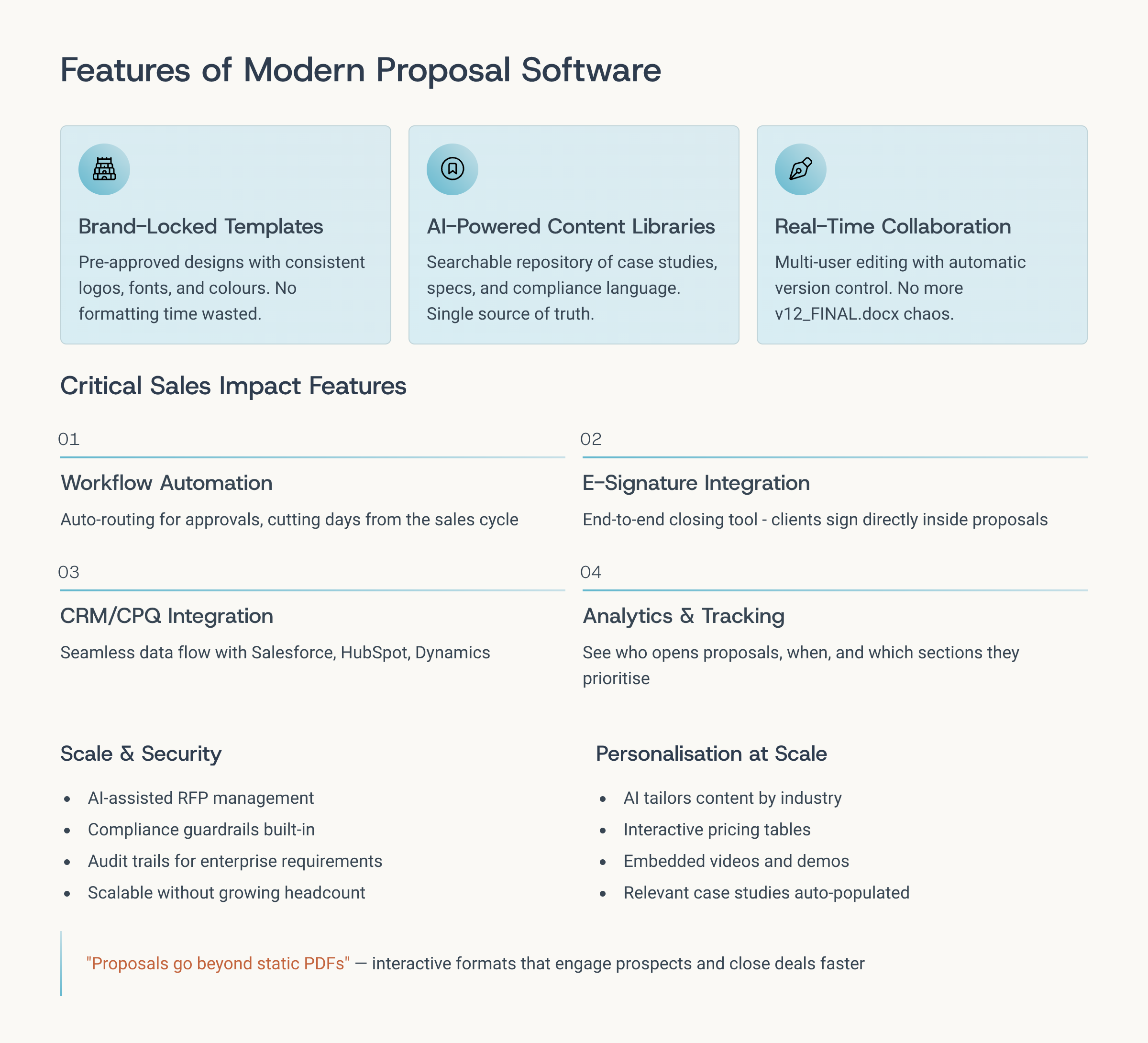
How to Evaluate a Proposal Software for Your Team
Choosing proposal software isn’t about picking the tool with the longest feature list. It’s about finding the platform that fits your team’s workflow, deal complexity, and growth goals. Here are the dimensions you should consider before making the call:
1. Alignment with Your Sales Motion
Ask: Are your deals simple, repeatable, and fast-moving, or complex, compliance-heavy, and multi-stakeholder?
SMBs sending dozens of quick proposals might prioritize speed and ease of use (templates, e-signature). Enterprises dealing with RFPs or complex pricing will need robust features like knowledge libraries, CPQ integrations, and compliance guardrails. The right tool should fit your existing rhythm, not force you to reinvent it.
2. Integration with Existing Systems
A proposal tool should feel like an extension of your CRM, not another silo. Check for native integrations with Salesforce, HubSpot, Microsoft Dynamics, or CPQ tools. Evaluate whether updates in proposals sync back to your CRM to keep pipeline data clean. Smooth integration saves time, reduces errors, and ensures adoption across sales, legal, and marketing.
3. Ease of Use and Adoption
The most powerful tool is useless if reps don’t adopt it. Look for intuitive interfaces, drag-and-drop editors, and simple workflows that don’t add friction. Run a pilot with a few reps to gauge adoption before rolling it out company-wide.
Bonus: check if the vendor offers training, support, and onboarding resources tailored to your team size.
4. Compliance and Security
For regulated industries (finance, healthcare, and government), compliance isn’t optional. Ensure the platform offers pre-approved content libraries, role-based permissions, audit trails, and SOC 2/GDPR compliance. Ask how often the vendor updates compliance features as regulations evolve. A proposal tool should reduce risk—not add to it.
5. Analytics and Reporting
Visibility is where proposal software pays off. Look for engagement analytics that show who opened the proposal, how long they spent on sections, and what got ignored. Evaluate whether the tool provides dashboards for managers to coach reps and forecast deals more accurately. Data should drive smarter decisions, not just prettier documents.
6. Scalability and Future Growth
Think beyond your current needs. If your proposal volume doubles next year, will the tool keep up? RFP-heavy teams should evaluate whether the platform supports bulk responses and AI-assisted answer libraries. SMBs should check if the platform grows into more advanced capabilities (like CPQ or contract lifecycle management) without requiring a switch. Scalability ensures you won’t outgrow your investment.
7. ROI and Business Case
Don’t just look at subscription cost—calculate value. Factor in time saved per proposal, reduction in errors, improvement in win rates, and shorter sales cycles.
Example: If reps save 10 hours per week and close 10% more deals, the ROI often dwarfs the software cost.
Vendors should be able to provide case studies and benchmarks to help you model this.
8. Vendor Reliability and Support
Proposal software is mission-critical. Downtime can cost you deals. Evaluate vendor track record, uptime guarantees, and support responsiveness. Check for customer reviews, reference calls, and whether they have experience with teams like yours. The right vendor is a partner, not just a software provider.
Evaluating proposal software is less about ticking boxes and more about fit. The best platform for your team is the one that:
- Matches your sales motion (fast and simple vs. complex and regulated).
- Integrates seamlessly with your CRM and tech stack.
- Provides adoption, compliance, and scalability without extra friction.
- Delivers measurable ROI in time savings, win rates, and deal velocity.
Pro tip: Run a short pilot with your top reps before committing. You’ll quickly see whether the tool accelerates deals—or just adds another login screen.
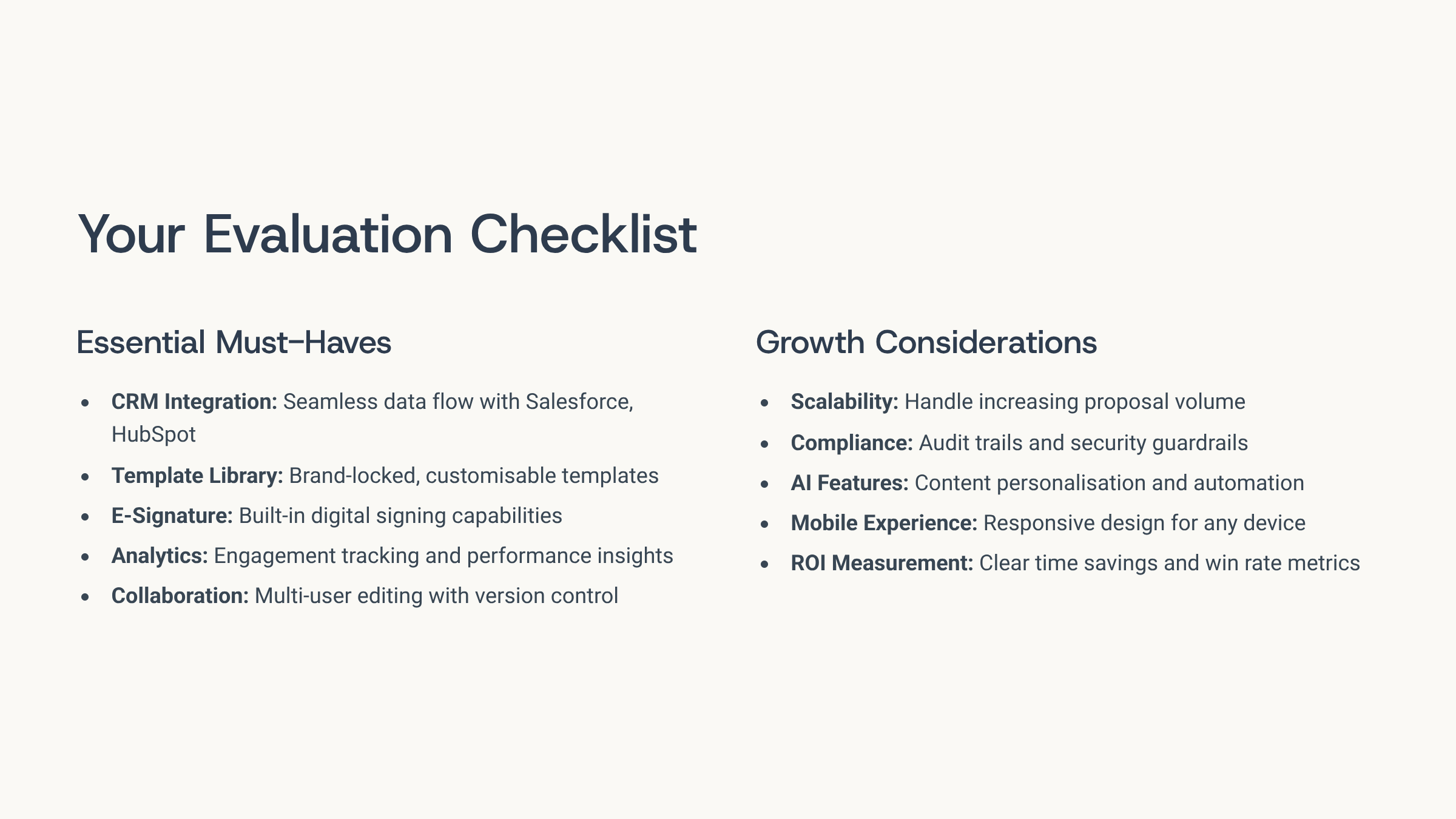
Conclusion
Sales proposal software solves the old headaches of slow, error-prone, inconsistent proposals—and replaces them with speed, brand consistency, buyer engagement, and measurable revenue gains.
And definitely, faster proposals get you to the table. Consistent proposals build trust. Together, they win you deals that you never thought you would.
Ready to see how AI can transform your RFP process?
Product Marketing Manager at SurveySparrow
A writer by heart, and a marketer by trade with a passion to excel! I strive by the motto "Something New, Everyday"
Frequently Asked Questions (FAQs)
Related Articles

Content Libraries for Proposals: Your Edge for Consistent Wins

What is Sales Content Management? A Definitive Guide 2026
